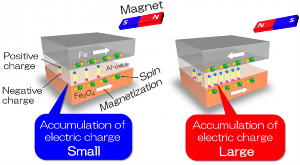Jun 2 2017
A key electronic component in various kinds of electrical circuits is a capacitor — a component with the ability to store and rapidly release a charge. Capacitors will have an equally significant role in next-generation 'spintronic' devices that are known to exploit not just electron charge but even spin, where spin is the minute magnetic moment possessed by each electron.
 A new study shows that anti-parallel electron spins between two electrodes create more capacitance than parallel spins, which is opposite of what is normally observed. (Credit: Brown University)
A new study shows that anti-parallel electron spins between two electrodes create more capacitance than parallel spins, which is opposite of what is normally observed. (Credit: Brown University)
Two years back, an international team of Researchers showed that by manipulating electron spin at a quantum magnetic tunneling junction- a nanoscale sandwich made of two metal electrodes with an insulator in the middle- they could induce a large increase in the junction's capacitance.
At present, the same team has conducted an unexpected experiment on the so-called magnetocapacitance phenomenon. The Researchers have demonstrated that when a quantum tunneling junction is built by using different materials, the capacitance could be changed by controlling spins in a manner opposite to “normal” magnetocapacitance. The outcomes of the research have been reported in a paper published in the Scientific Reports journal. According to the team, this inverse effect adds another functional phenomenon to the spintronics toolkit.
It gives us more parameter space to design devices. Sometimes normal capacitance might be better; sometimes the inverse might be better, depending on the application. This gives us a bit more flexibility.
Gang Xiao, Co-authors and Chair of the Physics Department at Brown University
According to Xiao, magnetocapacitors can play an especially important role in producing magnetic sensors for a wide array of spintronic devices such as computer next-generation random access memory chips and hard drives.
The study was the result of a partnership between the lab of Xiao at Brown University, Hideo Kaiju and Taro Nagahama’s lab at Hokkaido University in Japan and Osamu Kitakami’s lab at Tohoku University.
For many years now, Xiao has been analyzing magnetic tunneling junctions. The tiny junctions function very similar to capacitors in standard circuits. The insulator sandwiched between the conducting electrodes makes the free flow of current across the junction slow down, thereby creating resistance and one more phenomenon, namely, capacitance.
However, the tunneling junctions attract much attention specifically due to the fact that the amount of capacitance can be dynamically altered by controlling the electron spins inside the two metal electrodes. The electrodes are magnetic, that is, the electrons spinning inside each of the electrodes are pointed in one specific direction. The relative spin direction between two electrodes determines how much capacitance is present at the junction.
As part of their initial study on the phenomenon, Xiao and his colleagues demonstrated the highest possible change in the capacitance. They used electrodes made of iron-cobalt-boron to show that when electron spins are flipped from anti-parallel to parallel, the capacitance in experiments could be increased by 150%. Using these results, the Researchers formulated a theory speculating that when the conditions are ideal, the capacitance change can really reach 1000%.
Furthermore, the theory proposed that when electrodes formed out of different kinds of metals are used, an inverse magnetocapacitance effect, in which anti-parallel spins induce more capacitance compared to parallel spins, is created. This was precisely what the team demonstrated in their latest research.
We used iron for one electrode and iron oxide for the other. The electrical properties of the two are mirror images of each other, which is why we observed this inverse magnetocapacitance effect.
Gang Xiao, Co-authors and Chair of the Physics Department at Brown University
According to Xiao, apart from indicating a larger parameter space for exploiting magnetocapacitance in spintronic devices, the outcomes of the study also present significant verification for the theory used by Scientists to explain this phenomenon.
“Now we see that the theories fit well with the experiment, so we can be confident in using our theoretical models to maximize these effects, either the ‘normal’ effect or the inverse effect that we have demonstrated here,” stated Xiao.
The National Science Foundation (DMR-1307056), the Japan Society for the Promotion of Science (Grant-in-Aid for Scientific Research (B), 15H03981), the Japanese Ministry of Education, Culture, Sports, Science and Technology (Dynamic Alliance for Open Innovation Bridging Human, Environment and Materials), and the Center for Spintronics Research Network at Tohoku University supported the research.